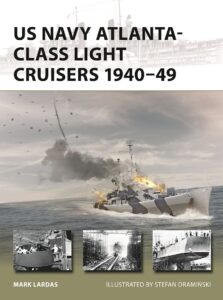Mark Lardas, US Navy Atlanta Class Light Cruisers 1940-49 (Osprey, 2025)
Imagine being a Japanese pilot in 1943 attempting to sink a US aircraft carrier, but there is a cruiser in the way, and it is throwing an awful lot of lead up at you. If that cruiser was an Atlanta class, you would probably be rethinking your career choice. This was one of the USN’s most effective anti-aircraft ships, and Mark Lardas tells us about them.
So much of the origin stories for warships in World War II lay in the restrictive naval treaties of the inter-war years. This was particularly true for the development of cruisers. For the US, that led to the introduction of the multi-mission Atlanta class, weighing in at about 7,400 tons and festooned with weapons. Lardas highlights the criteria for the new Atlanta class ships: tonnage and speed, with armament a lower priority. He notes that the biggest weakness was instability because of their high smokestacks and stacked gun batteries. The Atlantas carried the most effective dual-purpose guns of WWII, the 5in./38cal DP guns, in eight turrets, supplemented by 1.1in and Oerlikon 20mm close-range guns, Mk15 torpedoes, and twin depth charge racks placed at the stern. The US built four Atlantas then almost immediately ordered four more as the Oakland subclass, which were orientated more towards the anti-aircraft role. The USN then built the Juneau subclass based on lessons gleaned in the Pacific Theatre. These were pure anti-aircraft ships with many changes but still based on the Atlanta design. Lardas also illustrates the changes to the ships throughout the war, which made no two of them quite the same. Eight of the Atlantas served in the Pacific, with two, the Atlanta and Juneau, being sunk off Guadalcanal. Throughout the war, however, they fulfilled their purpose of throwing lots of lead into the air to foil Japanese aircraft. Their post-war service was short-lived in the new jet aircraft generation; one fought in the Korean War while some remained mothballed through the 1950s before being scrapped.
Lardas has written an informative survey on a very useful class of ships, even though they excelled in a role for which they were only partly designed. He is ably supported by Osprey’s usual high quality graphic design and selection of photographs. It is unfortunate that none of these elegant ships survive, but Lardas’s history of them adequately keeps the Atlanta class from being forgotten. Anyone interested in the USN during the Pacific War will appreciate this book.
